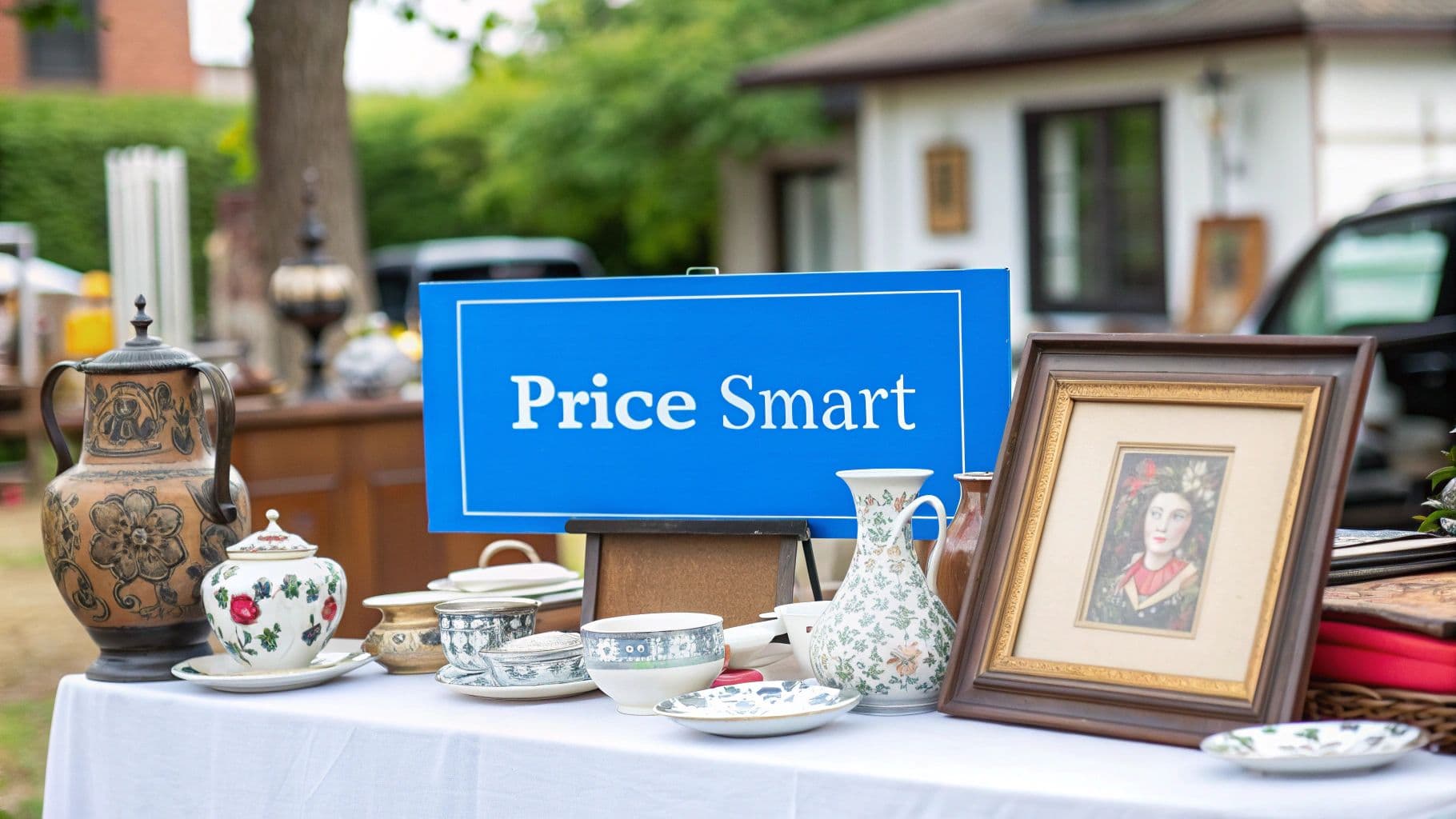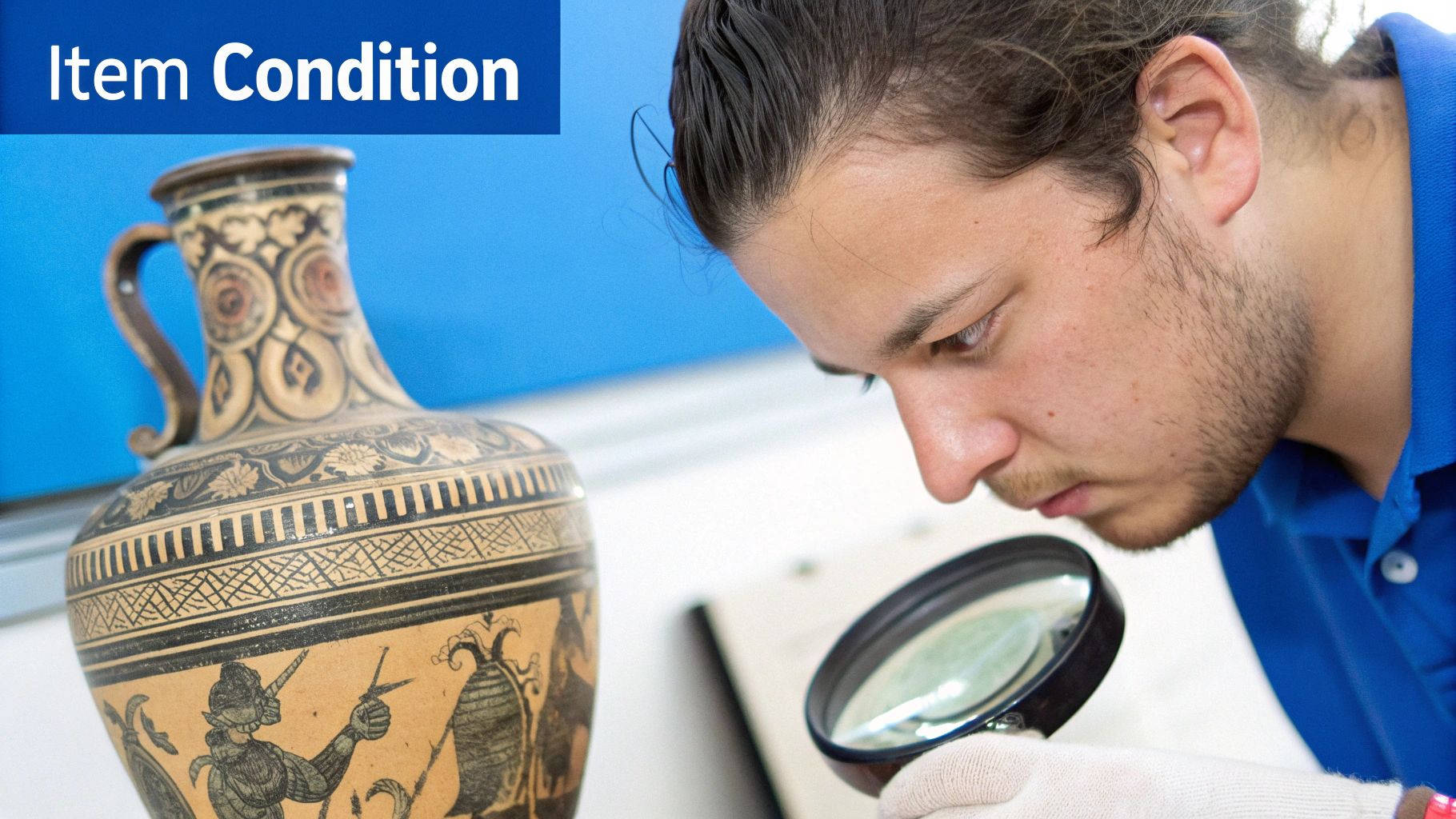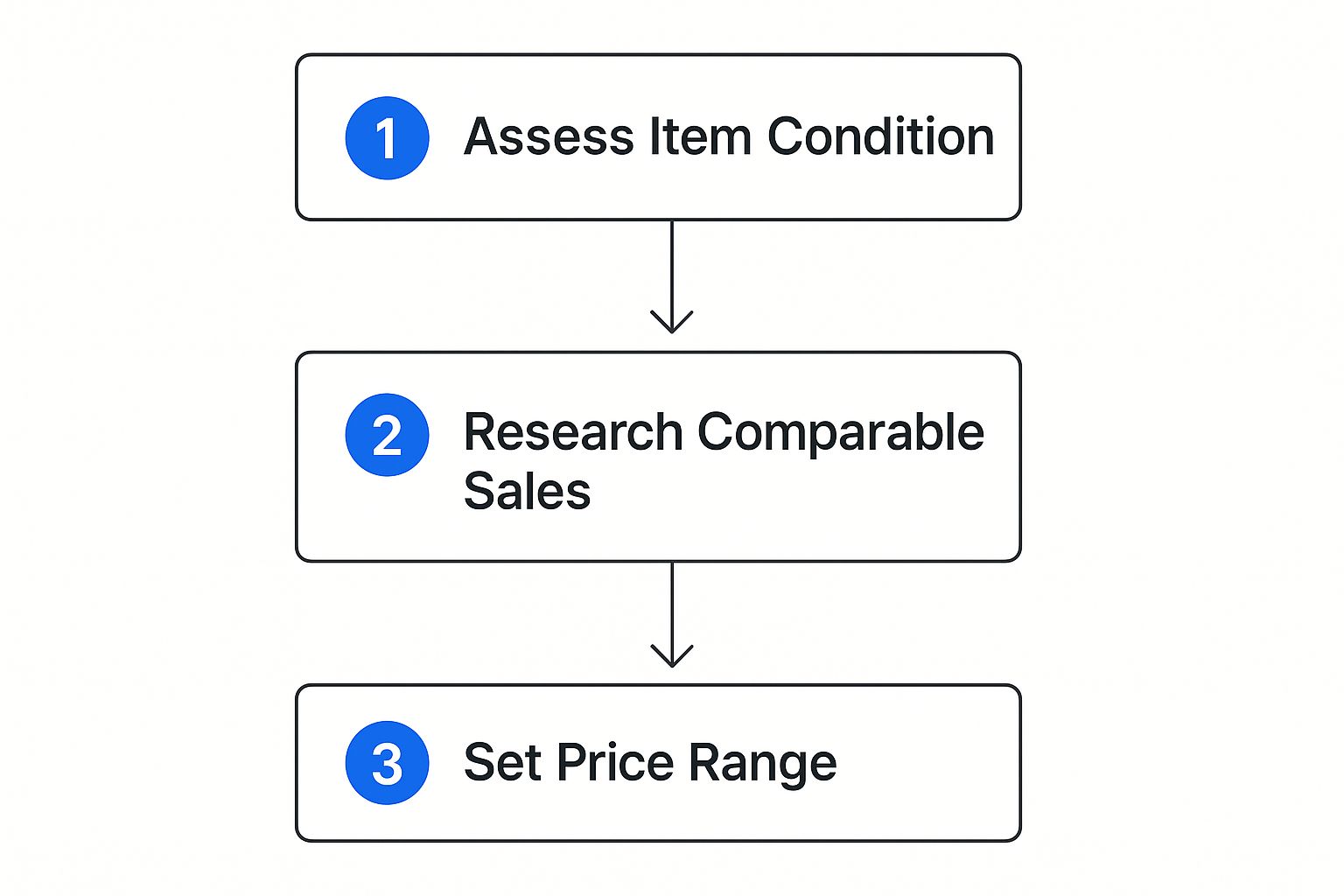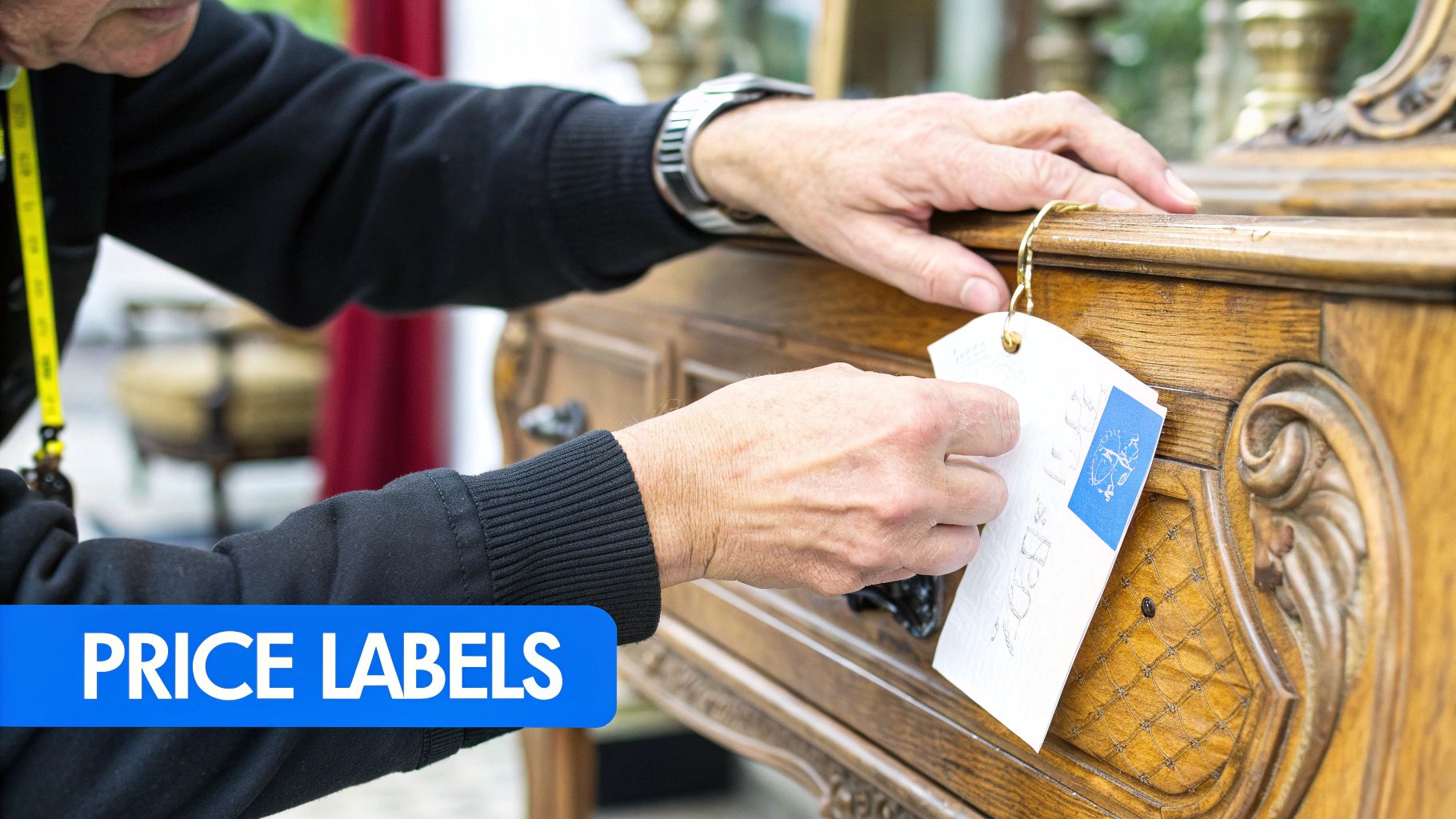How to Price Estate Sale Items for Maximum Profit

Getting your pricing right is where the magic happens in an estate sale. It’s a delicate dance between research and strategy, all centered around one core idea: fair market value. This isn't just a business term; it's the realistic price a knowledgeable buyer is actually willing to pay for an item right now.
The Foundation of Smart Estate Sale Pricing

Knowing how to price your items is less about guesswork and more about having a solid game plan. The real key to success is learning to look past your emotional connection to an object and see it for what the market says it's worth.
At its heart, fair market value has nothing to do with what an item cost 20 years ago or what you hope it's worth. It’s the sweet spot where supply and demand meet today. Nailing this is crucial—price too high and you'll watch shoppers walk away empty-handed, but price too low and you're leaving cash on the table.
To help you get a handle on this, let's break down the main things that drive an item's value. Once you get the hang of looking for these factors, you'll be able to confidently assess everything from grandma's fine china to the tools in the garage.
Key Factors Influencing Item Value
This table gives you a quick-reference guide to the core elements that determine what something is worth. Keep these in mind as you sort through your items.
| Factor | Description | Pricing Impact |
|---|---|---|
| Condition | The physical state of the item. Look for chips, scratches, fading, or missing parts. | High: An item in mint or near-perfect condition will always sell for more. Flaws significantly reduce value. |
| Demand | How popular or trendy an item is in the current market. | High: Mid-century modern furniture is hot right now. Victorian-era pieces? Less so. Trends directly drive prices up or down. |
| Rarity | How common or scarce the item is. Was it mass-produced or a limited edition? | High: A signed, first-edition book is far more valuable than a common paperback. Scarcity creates value. |
| Provenance | The item's history of ownership. Is there proof it belonged to someone notable? | High: A documented history, especially involving a famous person or event, can dramatically increase an item's worth. |
Considering these factors objectively is the best way to land on a price that makes sense for both you and your buyers.
A common trap is letting sentimental value creep into your pricing. A lifetime of memories attached to a piece of furniture doesn't translate into dollars. To stay objective, just ask yourself: "What would a stranger who knows their stuff be willing to pay for this today?"
This mindset also puts you in a similar position to the pros. Estate sale companies have to think this way to stay in business. They know the market and set minimums to ensure a sale is worthwhile. For example, by 2023, about 20.5% of companies were willing to manage sales with a minimum value of just $5,000, while another 14% set their minimums at $10,000 or more. If you want to dive deeper, you can explore more data about industry revenue benchmarks to see what the professionals are looking for.
Ultimately, your day-one prices set the tone and create momentum for the whole sale. When you ground your prices in solid research and market awareness, you build a foundation for success that clears out the house and maximizes your profit.
Mastering Your Item Research and Valuation

Okay, now that you know what makes an item valuable, it's time to roll up your sleeves. This is where the real work begins—turning a house full of mysteries into confidently priced assets. Forget about guesswork or what you think something should be worth. Solid, real-world data is your best friend here.
Your goal is to find actual evidence for every price you set. Luckily, there are some fantastic tools right at your fingertips that make this process much easier than it used to be. The trick is knowing which one to use for which item.
Start With Your Everyday Digital Tools
Your research journey can, and should, start with the device you already have in your pocket. Your smartphone is an incredible appraisal assistant if you know how to use it.
- Google Lens: Found a piece of pottery with a maker's mark you don't recognize? Don't just guess. Snap a quick photo with Google Lens. Its visual search can often identify the pattern, maker, and even show you similar items currently for sale online. It's a perfect first step.
- eBay's "Sold Items" Filter: This is an absolute must. Searching for what sellers are asking for an item is interesting, but seeing what buyers are actually paying is what matters. Always, always use the "Sold Items" filter to see the real-world prices from completed sales. This is a much truer reflection of market value.
Let's say you're pricing a "Vintage Pyrex Primary Colors Bowl." A quick search might show active listings ranging from $20 all the way up to $100. But when you filter by sold items, you might find they are consistently selling in the $35-$45 range. That’s your sweet spot.
Digging Deeper for the Real Treasures
While eBay is fantastic for common household goods and collectibles, you'll need to go a step further for the truly rare or high-value pieces. This is where you graduate from a quick search to a more serious investigation.
Think of it like this: eBay tells you what a Pyrex bowl sold for last week. A specialized database can tell you what a signed mid-century modern chair has sold for at auction over the past 5 years. That historical context is gold when pricing unique assets.
Pro Tip: Never, ever rely on a single sale price. Your mission is to find an average selling price from several sources. One unusually high or low sale is probably an outlier. Look for a consistent pricing pattern to guide you.
Essential Tools for In-Depth Valuation
For those items that feel special, you need to consult the pros' playbook. This means looking at auction result archives—the same resources professional appraisers use every day.
- LiveAuctioneers: This platform is an incredible resource that gathers auction results from thousands of auction houses worldwide. It's the go-to for finding real sales records for fine art, antiques, and other high-end collectibles.
- WorthPoint: A subscription to WorthPoint is a game-changer. It gives you access to a colossal database of sales records from hundreds of sources, including years of eBay history. It's probably the most powerful tool for finding what almost any antique or collectible has sold for.
By creating a simple research process—starting with quick visual searches and then diving into sales archives for the good stuff—you can systematically price everything in the estate. This evidence-based approach takes the anxiety out of pricing and makes sure you aren't accidentally leaving a ton of money on the table.
Developing a Strategic Pricing Structure for Your Sale
Good pricing isn't just about putting a sticker on each item. It's about building a cohesive strategy for the entire sale. Think of it like a retail store—you have different tiers of products designed to attract different shoppers and serve different purposes. Getting this layered approach right is a huge part of pricing estate sale items for a successful event.
First up are your “hero” items. These are the showstoppers: the signed antique dresser, the rare art piece, or the designer handbag that gets featured in your advertising. Price these at their full, well-researched fair market value. Their job is to create buzz and get serious collectors and buyers in the door on day one.
Next, you have the workhorses of your sale: the mid-range goods. This is where you'll find quality furniture, brand-name kitchen appliances, and nice home decor. These items make up the bulk of your revenue. Your research will give you a solid price range, and you can confidently tag them to sell steadily throughout the weekend.
Finally, never underestimate the power of your low-cost, “bread-and-butter” items. I'm talking about books, everyday kitchen utensils, linens, and craft supplies. They aren't big moneymakers on their own, but they create that addictive treasure-hunting vibe that keeps people browsing longer and filling their boxes.
This simple chart helps visualize how to decide where an item fits.

Walking through this process for every item helps you build a balanced inventory and a pricing structure that actually works.
Creating Momentum with Markdowns and Bundles
A static price list is a recipe for a house full of unsold items. For a multi-day sale, you need a dynamic markdown schedule to keep things moving and clear everything out by the end.
Here’s a classic, effective schedule that we see work time and time again:
- Day 1: Full price. This is non-negotiable. It rewards the early birds who want the best selection.
- Day 2: 25% off. This is a great incentive for anyone who was on the fence the first day to come back and buy.
- Day 3 (Final Hours): 50% off or more. At this point, the goal is liquidation. It's better to get something than nothing.
Beyond just slashing prices, get creative with bundling. A sign reading “Fill a bag with clothes for $10” or setting up a “Make an Offer” table in the final hours can turn leftover odds and ends into a surprising amount of cash. It moves inventory and adds to your bottom line.
It’s also helpful to understand the bigger picture. The estate liquidation industry is a significant market, with estimated revenues hitting $230.3 million by 2024 in the U.S. alone, according to an in-depth industry analysis by IBISWorld. Knowing these trends can give you confidence in your sale's potential.
If you’re thinking about hiring a company, you’ll want to understand how they charge for their services, too. Getting familiar with standard estate sale fees will help you weigh the costs and benefits of a DIY sale versus bringing in the pros.
Practical Tips for Tagging and Displaying Items

After all the legwork of researching and valuing your items, the price tag is where your strategy becomes real. How you present those prices is just as critical as the numbers themselves. I’ve seen it time and time again: clear, professional tagging doesn’t just make shopping easier, it builds trust and can even make an item feel more valuable.
The physical tag you use actually matters. Don't just slap any old sticker on a priceless antique. You need to match the tag to the item to avoid causing damage and to make sure the price is easy to see.
- String Tags: These are my go-to for anything delicate. Think collectibles, glassware, or clothing. They loop on easily without leaving behind any sticky gunk.
- Adhesive Stickers: These are fine for hard, non-porous surfaces like plastic storage bins, modern ceramics, or metal tools. Just promise me you won't put them on antique furniture, book covers, or anything with a painted finish—they can pull the surface right off.
- Colored Dots: This is a pro-level move for managing your markdown schedule. You can assign a color to each discount period. For example, a green dot might mean 25% off on Saturday, while a yellow dot signals 50% off on Sunday. It’s a simple visual system that makes everything clear for both you and your shoppers.
Make Your Tags Do More Than Show a Price
A good price tag should do more than just state a number. A little extra information can answer a shopper's questions before they even have to ask, which saves you a ton of time during a busy sale. A solid tag should always include the price, a brief description, and any notes about the item's condition.
For instance, a tag on a vintage lamp could say: "$45 - Mid-Century Ceramic Lamp. Works! Minor chip on base." That level of honesty shows you’re a trustworthy seller and helps people buy with confidence. It also shuts down any haggling attempts over flaws you've already pointed out.
Smart merchandising is your silent salesperson. Instead of piling all the dishes on one table and all the glasses on another, set the dining room table completely. A fully set table with priced china, silverware, and linens doesn't just look better—it sells better by showing buyers how the items can look in their own homes.
Display with a Purpose
Strategic display is about more than just avoiding a mess; it creates a genuine shopping experience. I always recommend grouping similar items to create little "departments," like a kitchen corner, a tool zone, or a craft supplies section. This helps people looking for specific categories find what they need without getting overwhelmed.
When it comes to big-ticket items like furniture, make sure there’s a clear path for buyers to walk around and inspect them from every angle. The worst thing you can do is block a beautiful dresser with boxes of junk. Your goal is to make the space feel less like a cluttered basement and more like a welcoming boutique where every item gets its moment to shine.
Common Pricing Mistakes and How to Avoid Them
Knowing how to price estate sale items is one thing, but knowing what not to do? That’s where the real expertise comes in. I've seen even the most well-researched sales get tripped up by a few classic blunders. Recognizing these pitfalls ahead of time is your best defense against a disappointing sale day.
One of the biggest and most costly mistakes is letting sentimental value dictate prices. The memories you have of family dinners around that old dining table, unfortunately, don't add a single dollar to its market value. When you price with your heart, you almost always price too high, and sharp-eyed buyers will just keep on walking.
The fix is simple: get an outside opinion. Grab a trusted friend, neighbor, or family member—someone without that emotional attachment—and have them do a quick once-over of your prices. Their objective view can be a huge reality check, especially for those items you're finding it hard to be impartial about.
Under-Researching and Inconsistent Pricing
Just as dangerous as overpricing is its sneaky cousin: under-researching. This is what happens when you’re in a hurry and start lumping things into generic categories. You might think all old books are worth a buck, but that assumption could lead you to sell a rare first edition for pocket change. That’s a mistake that can leave hundreds, if not thousands, of dollars on the table.
Another thing that drives buyers crazy is inconsistent pricing. Nothing erodes trust faster than finding identical glasses for $2 in the kitchen and $5 in the dining room. Messy, hard-to-read price tags do the same thing. It makes the whole sale feel disorganized and unprofessional, which makes shoppers question if the prices are fair at all.
Take a breath and be thorough. Every single item deserves a quick check, and your pricing and tagging system needs to be the same from the front door to the back porch. A little extra time spent here pays off big time in buyer confidence and final profits.
Keep in mind that the local economy also plays a subtle role. For example, the median sales price for houses in the U.S. was hovering around $416,900 in early 2025. When a home in that bracket is being liquidated, shoppers often walk in with certain expectations about the quality—and value—of what’s inside. You can discover more about real estate market conditions to get a feel for how this might shape buyer perceptions in your specific area.
Actionable Solutions for Common Errors
Steering clear of these problems really just comes down to having a good process. If you put a few simple checks in place, you can easily sidestep the issues that sink most DIY sales.
Here are a few practical tips I always share:
- The "Friend Test": For any item you feel sentimental about, just ask a friend, "Honestly, what would you pay for this?"
- Spot Check Everything: Never assume something is junk. Use a tool like Google Lens on your phone to do a lightning-fast check for markings on ceramics, art, and other oddities.
- Create a Pricing Key: Keep yourself consistent. Decide ahead of time that all paperbacks are $1, all hardcovers are $3, and all DVDs are $2. Write it down and stick to it.
- Clear, Legible Tags: Use pre-printed stickers or write very clearly. Clean, professional-looking tags signal that your prices are thoughtful and fair.
These small adjustments truly make a world of difference. For a deeper dive into other potential traps, check out our guide on the costly DIY estate sale mistakes you'll definitely want to avoid.
Answers to Common Estate Sale Pricing Questions
Even with a solid game plan for pricing your estate sale items, you're going to run into situations that feel… tricky. It happens to everyone. Let's tackle some of the most common questions that pop up, giving you clear answers to help you price with confidence.
Should I Hire a Professional Appraiser?
This is a great question, and the answer really comes down to what you're selling. For most of what you'll find in a home—everyday kitchenware, standard furniture, tools, and clothes—your own research is more than enough. It’s practical and much more cost-effective.
But for certain high-value categories, hiring a pro is an incredibly wise investment. Don't guess when it comes to:
- Fine art, especially from known artists
- High-end or antique jewelry
- Rare coin or stamp collections
- Authenticated antiques with a documented history (provenance)
Think of it this way: an appraiser is your insurance against a huge mistake, like letting a $5,000 painting walk out the door for $50. A fantastic middle-ground option is to hire an appraiser for a partial consultation. Have them focus only on the handful of items you suspect are truly valuable. You get the expert opinion where it counts without breaking the bank.
How Do I Price Damaged or Imperfect Items?
Honesty is everything here. Never, ever try to hide a flaw. Shoppers will find it, and you’ll lose their trust.
Instead, be completely upfront about it and price the item to move. A clear tag is your best tool. Something like: "Vintage Ironstone Platter - $8. Note: has a hairline crack on the back. As-is."
Items with damage need a steep discount from their mint-condition value—often 50-80% off, sometimes more. It might feel like you're taking a loss, but remember, you're not selling to a collector. You're selling to artists, DIYers, or furniture restorers who actively hunt for "project pieces." Pricing it low turns what might be destined for the trash into a quick sale.
Your goal with damaged goods isn't to hit a home run on profit. It's to liquidate the item fairly and efficiently. That honesty builds incredible trust with your shoppers and helps the item find a new home with someone who sees its potential, flaws and all.
Should I Price High to Leave Room for Haggling?
Yes, but just a little. For many shoppers, haggling is part of the fun of an estate sale. They expect it, and some genuinely enjoy the friendly negotiation. Building a small cushion into your prices is a smart, strategic move.
As a general rule, pricing items about 10-15% higher than your rock-bottom price is the sweet spot.
This gives you just enough wiggle room for a negotiation that makes the buyer feel like they got a deal, but it doesn't make your initial prices seem outrageous. If you inflate prices too much, you risk scaring off serious buyers who think everything is overpriced. For those special items where you're not willing to budge, simply mark the tag as "Firm."
What Is the Best Way to Price Large Collections?
Staring at a wall of books, a mountain of records, or shelves of figurines can feel totally overwhelming. The secret is to stop thinking about pricing every single item individually. That path leads to madness. Instead, create a tiered system.
First, sift through the collection and pull out the "heroes"—any rare, signed, or especially valuable pieces. These get researched and priced on their own.
For everything else, create simple, standardized prices that are easy for shoppers to understand.
For example:
- Books: All paperbacks $1, all hardcovers $3. Easy.
- Records: Set up a "$1 Bin" for common albums, a "$5 Bin" for more popular artists, and then have a separate, clearly marked section for the individually priced collectibles you pulled out earlier.
This method saves you a massive amount of time and makes browsing a breeze for your customers, encouraging them to buy in bulk. You get volume sales on the common stuff while still getting top dollar for your most valuable items.
For even more detailed answers to specific scenarios, you can explore our ultimate estate sale FAQ to build on what you've learned here.